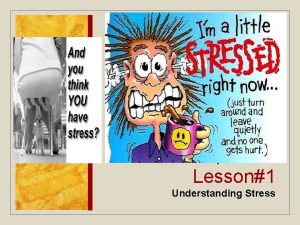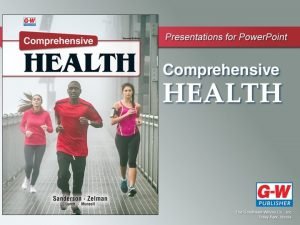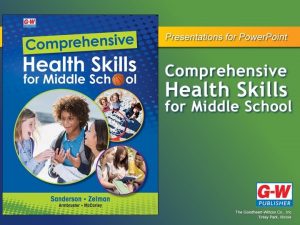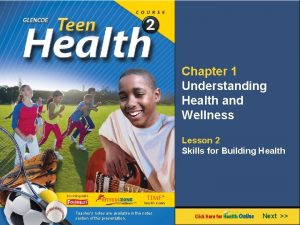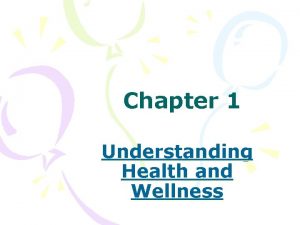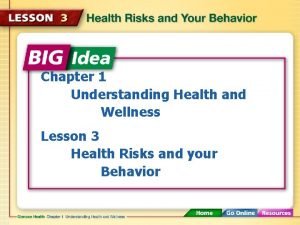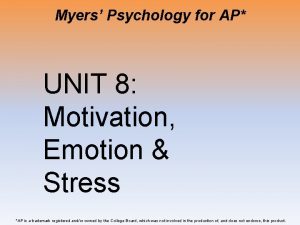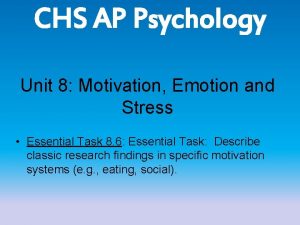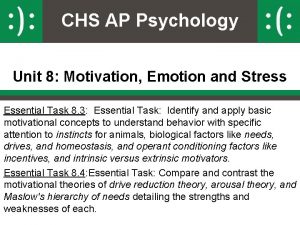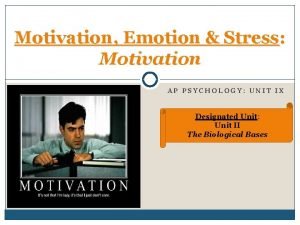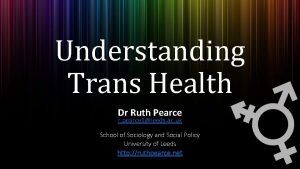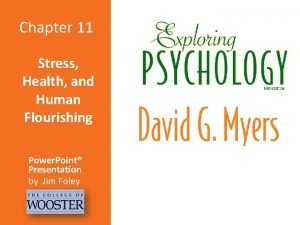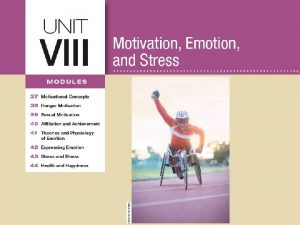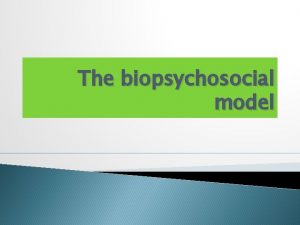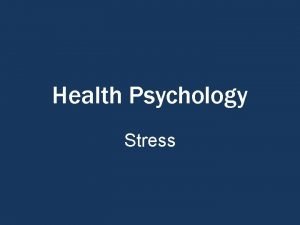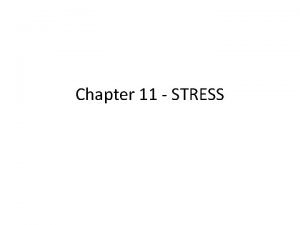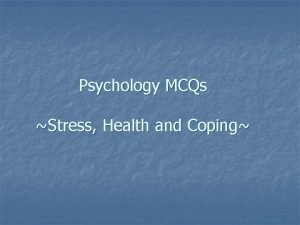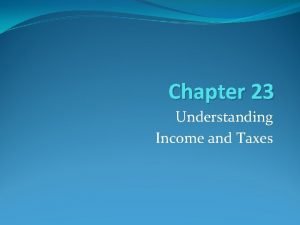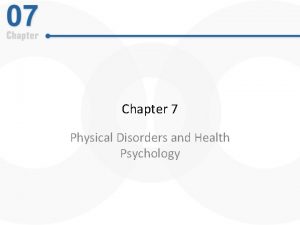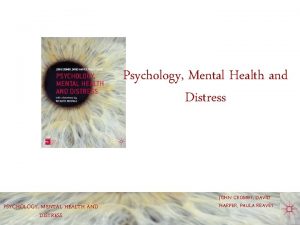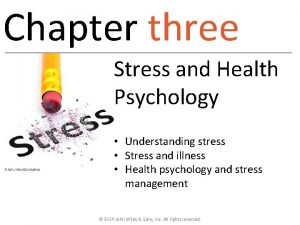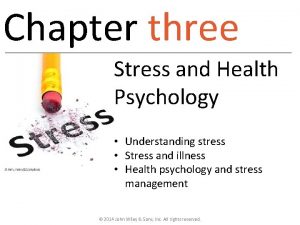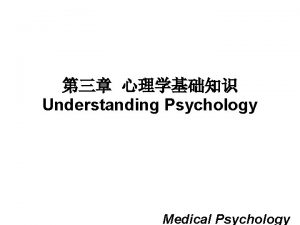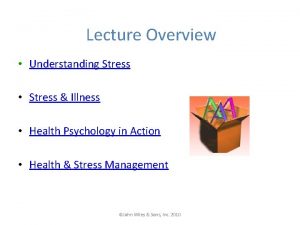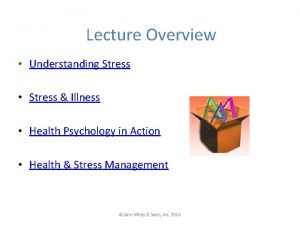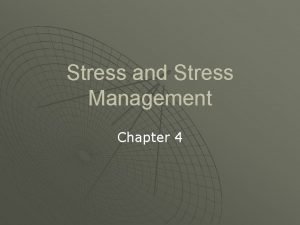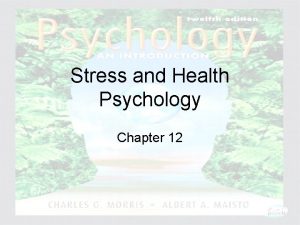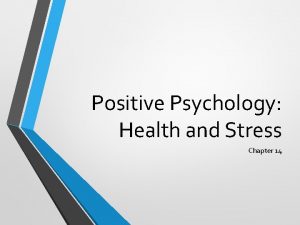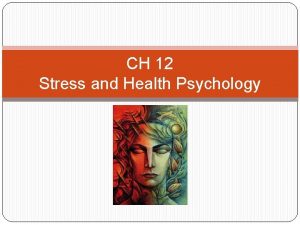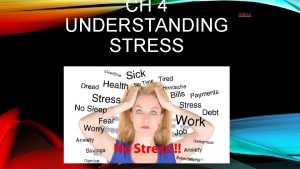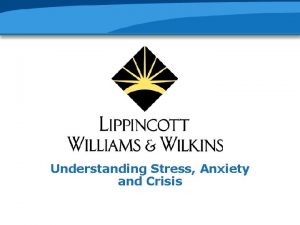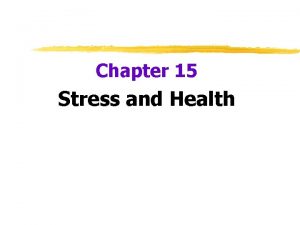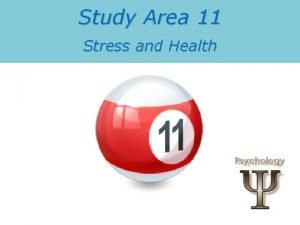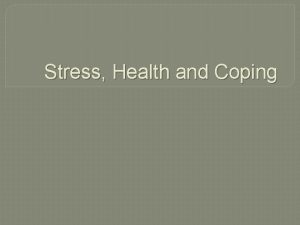CHAPTER 3 Stress and Health Psychology Understanding Stress



































- Slides: 35

CHAPTER 3 Stress and Health Psychology • • Understanding Stress and Illness Stress Management Health Psychology © 2016 John Wiley & Sons, Inc. All rights reserved.

Real World Psychology Things you’ll learn in Chapter 3 Q 1 Does frequent checking of your email and social media increase your stress? Q 2 Can the stress of growing up in poverty cause changes in your brain? Q 3 Does watching televised coverage of natural disasters increase symptoms of posttraumatic stress disorder? Q 4 Could thinking about the “silver linings” of a stressful event, or sharing it with others, reduce depression? Q 5 Are people with stressful jobs at increased risk of experiencing a heart attack? © 2016 John Wiley & Sons, Inc. All rights reserved.

Understanding Stress What is Stress? • Stress = the interpretation of specific events as threatening or challenging • Stressor = trigger or stimulus that induces stress What stressors cause stress for you? © 2016 John Wiley & Sons, Inc. All rights reserved.

Understanding Stress Sources of Stress FIGURE 3. 1 © 2016 John Wiley & Sons, Inc. All rights reserved.

Understanding Stress Acute Versus Chronic Stress • Acute – Generally severe but short-term • Narrowly avoiding an accident • Missing an important deadline • Chronic – Continuous; demands exceed perceived resources • Prejudice and discrimination • Alcoholism • Abuse • War • Financial problems © 2016 John Wiley & Sons, Inc. All rights reserved. FIGURE 3. 2

Q 1 Does frequent checking of your email and social media increase your stress? • Making and maintaining friendships require considerable amount of thought and energy (Ehrlich et al. , 2016) • Research suggests that your stress level increases with the more social media “friends” you have and the more time you spend on social networking sites. (Beven et al. , 2014; Morin. Major et al. , 2016) © 2016 John Wiley & Sons, Inc. All rights reserved.

Understanding Stress Sources of Stress (continued) • Job Stressors – Unemployment – Job change – Job performance concerns – Inherently stressful job/career • e. g. , first responder, law enforcement – Role conflict – Role ambiguity © 2016 John Wiley & Sons, Inc. All rights reserved.

Understanding Stress Sources of Stress (continued) • Conflict – Approach-approach • Choosing between two desirable options – Avoidance-avoidance • Choosing between two undesirable options – Approach-avoidance • One option has both positive and negative characteristics © 2016 John Wiley & Sons, Inc. All rights reserved. TABLE 3. 1

Understanding Stress Sources of Stress (continued) • Hassles – Can lead to burnout • Frustration – Resulting from a blocked goal • Cataclysmic events – Happens suddenly, affecting many people simultaneously © 2016 John Wiley & Sons, Inc. All rights reserved.

Understanding Stress Reactions to Stress • General Adaptation Syndrome (GAS) Hans Selye – Our bodies are well designed for temporary stress, but poorly prepared for chronic stress • Three Phases – Alarm – Resistance – Exhaustion PROCESS DIAGRAM 3. 1 © 2016 John Wiley & Sons, Inc. All rights reserved.

Understanding Stress Reactions to Stress (continued) The SAM System The HPA Axis PROCESS DIAGRAM 3. 2 © 2016 John Wiley & Sons, Inc. All rights reserved.

Understanding Stress Reactions to Stress (continued) • Stress and the Immune System – Our bodies release cortisol to help combat a stressor; but, chronically high cortisol levels suppress the immune system – Psychoneuroimmunology studies the effects of psychological and other factors on the immune system • Stress and cognitive functioning – Even short-term stress affects ability to think clearly © 2016 John Wiley & Sons, Inc. All rights reserved. our

Q 2 Can the stress of growing up in poverty cause changes in your brain? • Researchers have found poverty (a chronic stressor) to be associated with particular differences in certain surface areas of the brain essential for academic success. (Noble et al. 2015) • MRI brain scans of children who grow up in poverty show several important differences in brain structure in areas known to be among the most crucial for academic achievement. (Hair et al. , 2015) © 2016 John Wiley & Sons, Inc. All rights reserved.

Understanding Stress Reactions to Stress (continued) Our brain under chronic stress FIGURE 3. 3 © 2016 John Wiley & Sons, Inc. All rights reserved.

Understanding Stress Benefits of Stress • Eustress – Pleasant, desirable stress – Arouses us to persevere and accomplish challenging goals • Distress – Unpleasant, undesirable stress – Caused by adverse conditions © 2016 John Wiley & Sons, Inc. All rights reserved.

Understanding Stress Benefits of Stress FIGURE 3. 4 © 2016 John Wiley & Sons, Inc. All rights reserved.

Stress and Illness Gastric Ulcers • Condition: lesions to the lining of the stomach and upper small intestines • How worsened: bacterium (H. plyori) damages the stomach wall – Found in the majority of people, but only in people compromised by stress does it cause ulcers • How aided: antibiotics © 2016 John Wiley & Sons, Inc. All rights reserved.

Stress and Illness Cancer • Condition: when cells divide rapidly, forming a tumor and invading healthy tissue • How worsened – Our immune systems attack abnormal cells, but immune systems compromised by stress are less able to fight cancerous growth – Stress increases the spread of cancer cells to other organs • How aided: widely varies (surgery to no cure) © 2016 John Wiley & Sons, Inc. All rights reserved.

Stress and Illness Cardiovascular Disorders • Condition: includes coronary heart disease, angina and heart attack • How worsened: stress hormones increase heart rate – Fat and glucose are sent into the blood for energy, but if no physical activity occurs, fat in the bloodstream sticks to the walls of blood vessels • How aided: diet, exercise, reduce stress © 2016 John Wiley & Sons, Inc. All rights reserved.

Stress and Illness Posttraumatic Stress Disorder (PTSD) • Condition: long-lasting and trauma- and stressor-related disorder that overwhelms an individual’s ability to cope – Stems from exposure to serious or recurring trauma • How worsened: varies by individual and situation • How aided: counseling/therapy, avoidance of stressors, support, time, medications © 2016 John Wiley & Sons, Inc. All rights reserved.

Stress and Illness Posttraumatic Stress Disorder (continued) Key Characteristics of PTSD 1. Direct exposure to trauma - personal experience, witnessing it or learning that it happened to others 2. Recurrent, intrusive symptoms - thoughts, feelings, memories, bad dreams and/or re- experiencing the trauma via flashbacks SEE TABLE 3. 2 © 2016 John Wiley & Sons, Inc. All rights reserved.

Stress and Illness Posttraumatic Stress Disorder (continued) Key Characteristics of PTSD (continued) 3. Avoidance symptoms - feeling emotionally numb, losing interest in previously enjoyable activities, avoiding memories of the trauma and/or stimuli associated with the traumatic event 4. Chronic heightened arousal and reactivity - irritability, being easily startled, sleep disturbances, angry outbursts, and reckless / self SEE TABLE -destructive behaviors © 2016 John Wiley & Sons, Inc. All rights reserved. 3. 2

Q 3 Does watching televised coverage of natural disasters increase symptoms of posttraumatic stress disorder? • Research shows that simply watching televised coverage of major natural disasters - such as hurricanes, earthquakes and tornadoes can increase the number of PTSD symptoms, especially in children who are already experiencing symptoms (Holman et al. , 2014; Weems et al. , 2012) © 2016 John Wiley & Sons, Inc. All rights reserved.

Stress and Illness Tips for Coping with Crisis 1. Yourself: Recognize your feelings – talk to others 2. Someone you know: Be willing to listen – encourage 3. Yourself and others: Be patient and kind – be understanding of reactions to stress 4. Recognize normal crisis reactions 5. Be mindful of your time – say ‘no’ – limit watching news – spend time with significant people – do something you enjoy 6. Plenty of sleep – avoid alcohol and drugs 7. Study and adopt stress management skills SEE TABLE 3. 3 © 2016 John Wiley & Sons, Inc. All rights reserved.

Stress Management Cognitive Appraisal • Goal: management, not elimination • Primary appraisal – Is the situation (potentially) harmful? If yes: • Secondary appraisal – What (potential) resources are available? – Coping method • Emotion-focused (regulate our reactions to the stressor) • Problem-focused (reduce or eliminate the stressor) © 2016 John Wiley & Sons, Inc. All rights reserved.

Stress Management Cognitive Appraisal PROCESS DIAGRAM 3. 3 © 2016 John Wiley & Sons, Inc. All rights reserved.

Q 4 Could thinking about the “silver linings” of a stressful event, or sharing it with others, reduce depression? • Teenagers were asked to think about the “silver lining” benefits of a recent stressful event show increases in positive mood and decreases in negative mood. (Rood et al. , 2012) • Instant messaging (IM) has also been shown to help distressed teenagers by sharing their emotions and receiving immediate social support and advice. (Dolev-Cohen & Barak, 2013) © 2016 John Wiley & Sons, Inc. All rights reserved.

Stress Management Personality and Individual Differences • Locus of Control – Internal (‘I control my own fate’) – External (‘Outside forces determine my fate’) • Positive Affect – The experience/expression of positive feelings (happiness, joy, enthusiasm, contentment) • Optimism – Expect and see the best in everything © 2016 John Wiley & Sons, Inc. All rights reserved.

Stress Management Resources for Healthy Living • Mindfulness-based Stress Reduction (MBSR) – Training aimed at consciously attending to ongoing events in a receptive and nonjudgmental way • Social support – Those with greater social support have better health outcomes, greater psychological and physical well-being, faster recoveries and longer life expectancies © 2016 John Wiley & Sons, Inc. All rights reserved.

Stress Management Additional Stress Resources Exercise Behavior Change Material Resources Social skills Stressor Control Relaxation © 2016 John Wiley & Sons, Inc. All rights reserved.

Health Psychology What Health Psychologists Do • Functions – Study the effects of stress on the immune system – Reduce psychological distress – Eliminate unhealthy behaviors – Educate public about health maintenance • Venues – Medical center staff – Independent clinicians © 2016 John Wiley & Sons, Inc. All rights reserved.

Health Psychology Biopsychosocial Model of Addiction FIGURE 3. 8 © 2016 John Wiley & Sons, Inc. All rights reserved.

Q 5 Are people with stressful jobs at increased risk of experiencing a heart attack? • Some research suggests that job stress and overwork can greatly increase your risk of dying from heart disease and stroke. (Biering et al. , 2015; Charles et al. , 2014; Huang et al. , 2015) karoshi – ‘death from overwork’ • People with stressful jobs are 23% more likely to experience a heart attack than those without stressful jobs. (Kivimäki et al. , 2012) © 2016 John Wiley & Sons, Inc. All rights reserved.

Health Psychology Technostress and Job Stress • Technostress two definitions: – Stress stemming from overexposure or involvement with technology or – Stress caused by an inability to cope with modern technology • Resources to aid job-related stress – Supportive colleagues – Supporting working conditions – Mentally challenging work – Equitable rewards © 2016 John Wiley & Sons, Inc. All rights reserved.

© 2016 John Wiley & Sons, Inc. All rights reserved.
 Glencoe health chapter 1 understanding health and wellness
Glencoe health chapter 1 understanding health and wellness Chapter one understanding health and wellness
Chapter one understanding health and wellness Chapter 4 lesson 1 understanding stress
Chapter 4 lesson 1 understanding stress Chapter 10 stress responses and stress management
Chapter 10 stress responses and stress management Understanding your health and wellness chapter 1
Understanding your health and wellness chapter 1 Understanding your health and wellness
Understanding your health and wellness Understanding your health and wellness chapter 1
Understanding your health and wellness chapter 1 Chapter 1 lesson 4 promoting health and wellness
Chapter 1 lesson 4 promoting health and wellness Chapter 1 lesson 2 what affects your health
Chapter 1 lesson 2 what affects your health Understanding health and wellness
Understanding health and wellness Chapter 1 understanding health and wellness lesson 3
Chapter 1 understanding health and wellness lesson 3 Health psychology definition ap psychology
Health psychology definition ap psychology Altruism
Altruism True stress vs engineering stress
True stress vs engineering stress Understanding standards psychology assignment
Understanding standards psychology assignment Chapter 3 health wellness and health disparities
Chapter 3 health wellness and health disparities Unit 8 myers ap psychology
Unit 8 myers ap psychology Unit 8 motivation and emotion
Unit 8 motivation and emotion Unit 8 ap psychology
Unit 8 ap psychology Ap psychology motivation and emotion activities
Ap psychology motivation and emotion activities Definition of normal stress
Definition of normal stress Understanding trans health
Understanding trans health Stress health and human flourishing
Stress health and human flourishing Module 43 stress and health
Module 43 stress and health Diathesis stress model
Diathesis stress model Stress definition psychology
Stress definition psychology Selyes general adaptation syndrome
Selyes general adaptation syndrome Diathesis psychology
Diathesis psychology Concept of stress and coping mcqs
Concept of stress and coping mcqs Health and social component 3
Health and social component 3 Chapter 23 understanding income and taxes
Chapter 23 understanding income and taxes Understanding and comparing distributions
Understanding and comparing distributions Physical disorders and health psychology
Physical disorders and health psychology Psychology, mental health and distress
Psychology, mental health and distress Enrich health and psychology
Enrich health and psychology Positive psychology ap psychology definition
Positive psychology ap psychology definition


